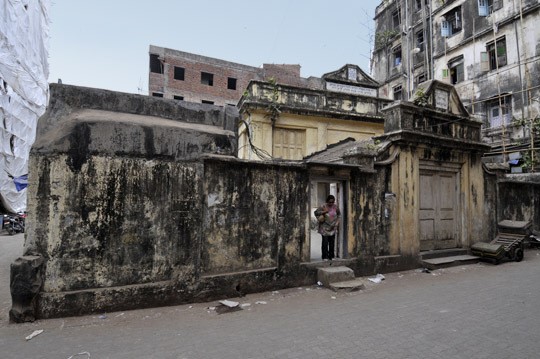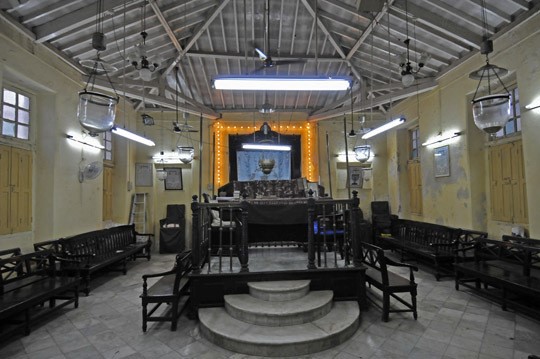SHAAR RASON SYNAGOGUE (1843)
90, Tantanpura Street
Mandvi
Mumbai
Maharashtra, INDIA
This synagogue remains open with a small congregation, and visiting it is possible. Normally no caretaker is there to receive guests, yet a contact for an arranged visit is Judah Samuel at
This email address is being protected from spambots. You need JavaScript enabled to view it.. Note, the Mumbai police are stationed at the synagogue at all times to guard the property, and they don’t seem to like unscheduled visitors hanging around. Also, they don’t have keys to the buildings, so they won’t be helpful. Another Bene Israel synagogue, Shaar Rason, is located very nearby within easy walking distance. Refer to its page on this website for additional information.
In 1839, Samuel Jacob Divekar, Haeem Isaji (Isaac) Garsulkar, with other Bene Israel Jews in Mumbai who had formed the new Shaar Rason congregation, subscribed a sum of Rs. 2725 for the purchase of land for this synagogue site. The acquisition of the property took place on the 22nd of December 1840. During the period that the synagogue was being planned and built, the membership rented a room in a building owned by Daniel Kehimkar Maistry. On the 4th of June 1843, Shaar Rason Synagogue was consecrated.
For their first decades in Mumbai, the Bene Israel Jews conducted prayer services in private homes or borrowed facilities. By the closing years of the eighteenth century, the growing community needed proper synagogues as religious, educational, and social centers of Jewish life. Shaar Rason, Hebrew for Gate of Will, was the second Bene Israel synagogue to be built in Mumbai. It was located at 90, Tantapura Street in the congested Mohalla, Khadak area of the city, within easy walking distance from the first Bene Israel synagogue, Shaar Harahamim (Gate of Mercy) at 245, Samuel Street. Shaar Harahamim became known as the “Old Synagogue,” and Shaar Rason as the “New Synagogue.” The new synagogue was constructed from voluntary contributions raised by a group dissatisfied with the old synagogue who established their own congregation.
Shaar Rason is surrounded by a thick solid wall interrupted only by a couple of openings. The main gateway is detailed with a pediment with an inscription and pair of wooden doors opening into the synagogue compound. The property wall, built of simple structural brick veneered in chunam (polished lime shale and sand), is connected to a gabled roof breezeway that abuts the synagogue. The architecture of the synagogue is solid in appearance, with few doors and windows. The ornamentation includes simple moldings, unadorned pilasters, and a recessed-paneled roof parapet crowned by a swooping feature that reflects the one atop the gate pediment. This projection includes a Hebrew verse, the name of the synagogue in Hebrew, and a Magen David (Star of David). Like other local buildings, the sloped roofs of the breezeway and the synagogue are framed in wood and covered with flat ceramic tiles. The roof overhangs are steep, in response to Mumbai’s annual monsoons and hot climate.
A covered breezeway leads to the entry doors of the sanctuary and a stair up to the women’s seating gallery. In contrast to the synagogue’s reserved and very weathered exterior, the interior is lively and orderly. One enters the synagogue by passing under the women’s gallery in a low area that serves as an anteroom and then passing by a pair of classical columns into the sanctuary. The thick chunam walls of the sanctuary are painted a pale color, and the room is lined with painted wood shuttered openings with divided-light transoms above. The sanctuary’s open ceiling provides volume to the space. Common to many buildings of this region and vintage, the roof framing, in painted wood, is exposed. The result is a charming and intimate, human-scaled space.
The rectangular sanctuary follows the spatial planning of other Bene Israel synagogues with their centrally-positioned raised tebah (bimah, or reader’s platform from where the Torah is read) and, to the far wall, the heckal (ark). The tebah, fabricated out of local teak, includes raised wooden panels at its base, turned newel posts and brass balusters, and a shaped handrail. As is traditional, the reading desk is covered by a special fabric. Shaar Rason’s heckal, a cabinet against the wall that is used for storing the Torah scrolls, is constructed out of teak and beautifully carved. The heckal is draped in the traditional cloth called the parochet and raised off the floor by a few steps. Small bulbs surround the heckal, dramatizing this central feature.
Shaar Rason’s interior includes light gray stone floor pavers, framed Hebrew prayer verses displayed around the room, fluorescent-tube sconces, and ceiling fans hung from the walls. A variety of ceiling fans, glass lanterns, and lighting fixtures hang from the sloped ceilings. Other architectural and liturgical design features are the freestanding wooden benches along the perimeter of the sanctuary and the matching pair of draped chairs flanking the heckal. These chairs are dedicated to Elijah and the circumcision ceremony. Shaar Rason’s compound includes a small outdoor space, used over the years for religious and social celebrations, as well as housing for a caretaker. The synagogue still serves a small, active congregation.
According to oral history, the Bene Israel Jews came to India in ancient times as traders from the Middle East. Perhaps as long as two thousand years ago, they settled in small towns and villages in the Raigad District within the Konkan Region of coastal Maharashtra. They lived here for centuries, following various Jewish customs and practices while coexisting among the greater Indian population. Many years later, beginning in the late eighteenth century and continuing into the next century, some of the Bene Israel relocated to Mumbai, Ahmedabad, Pune, and Karachi, when these then-British cities were expanding and offering employment and other opportunities.
Now more than a century and three-quarters old, Shaar Rason is a testament to Mumbai’s noble tradition of diversity and tolerance.

Exterior

Interior








